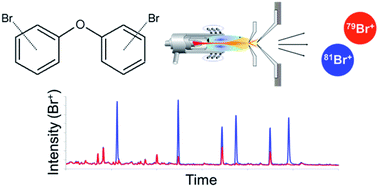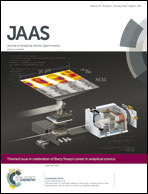Optimizing GC-ICP-MS for ultra-trace quantification of PBDEs in natural water samples using species-specific isotope dilution†
Abstract
Due to the increased interest regarding the fate, transport and toxic effects of polybrominated diphenyl ethers (PBDEs) within the aquatic environment a variety of different methods have been reported, trying to fulfil the requirements of the European Water Framework Directive (WFD, Directive 2000/60/EC). For PBDEs the WFD specifies Environmental Quality Standards (EQS) at very low trace levels, which correspond to 0.5 ng L−1 for 6 priority brominated flame retardants. The reliable quantification of such low concentration levels in environmental sample matrices requires the development of new analytical approaches. Current standard GC-MS methods, which are frequently used for PBDE analysis, often do not provide sufficient sensitivity for their reliable analysis at ultra-trace levels. Within this context a new GC-ICP-MS method has been developed and optimized allowing the ultra-trace determination of the selected priority congeners at sub ng L−1 levels. The quantification approach is based on the application of 81Br labelled PBDEs as internal standards for species-specific isotope dilution analysis. Natural water samples were analysed to demonstrate the potential of this new detection and quantification approach.

- This article is part of the themed collection: Themed issue dedicated to Barry Sharp

 Please wait while we load your content...
Please wait while we load your content...